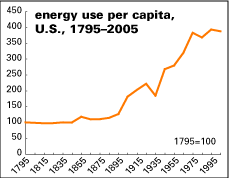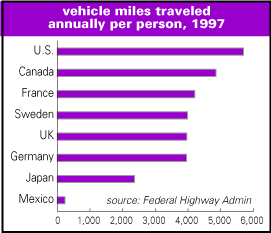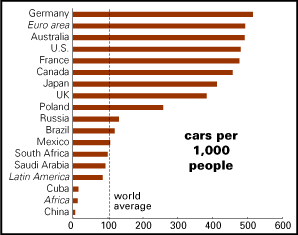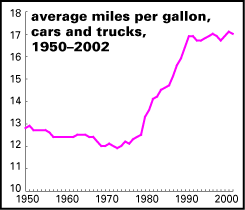
Home Mail Articles Stats/current Supplements Subscriptions Radio
The following article appeared in Left Business Observer #109, November 2004. It retains its copyright and may not be reprinted or redistributed in any form - print, electronic, facsimile, anything - without the permission of LBO.
Driving madness
Since the first installment of LBO’s series on oil in #108 [not on this site], crude prices have continued to rise (though they fell a bit off their highs as this issue was going to press). The reasons are the same as those behind the long price rise from the December 2001 low: strong growth in demand, led by China, with the U.S. seriously pitching in; political anxieties in major producing regions, like Iraq and Nigeria; and tight supplies, with most producers pumping full out and few major discoveries of oil reserves. To those could be added recent weakness in the U.S. dollar, the currency in which oil is priced; since the 2001 low, oil priced in dollars is up about 160%, but to buyers with euros, it’s up just half as much. And add to that a flow of speculative money into the oil market, which can take prices beyond any “rational” level.
It may be that we’ve seen the speculative blowoff in the oil market, and prices are about to settle back to a more comfortable level. It may also be that major economies are slowing enough to cool down the demand for oil. While that would be good news in the short-term—slack economies and weakening labor markets aren’t good for most people—it would be a shame if attention were deflected from oil as a significant political and economic issue.More
To the orthodox, the way to deal with rising demand is to increase supply. In the short-to-medium run, that’s not impossible. Eager to please shareholders, oil companies have kept a tight lid on their exploration budgets—and the brevity of the roster of recent discoveries reflects that. If they boosted their exploration budgets, the roster might get a little less brief. But over the longer term, that’s not a promising strategy. Even respectable sources like PFC Energy, the Washington-based consultancy, are saying that we’re ten or twenty years away from the peak in global oil production, and new finds are unlikely. We’ve heard that many times, from the beginning of the oil era over a century ago, so some skepticism is warranted. But more urgently, the ecological consequences of burning the oil we do have—more than 40 years worth at current rates of consumption—are unacceptably horrific.
Less
So the more urgent task is cutting consumption. And since China is still a poor country, despite its long boom, it doesn’t seem right to ask them, or any other poor country, to renounce oil. The biggest energy hog in the world is the United States, and for nothing less than the sake of life on this planet, we’ve got to cut back—seriously, and soon. Not that that’s likely.
A bit over a quarter of the energy we use goes to transportation, and that is overwhelmingly oil-based. So if we’re going to reduce oil consumption in any meaningful way, we’ve got to rethink the way we move around.
The U.S. consumes about twice as much of the principal transportation fuels (gasoline and the so-called middle distillates, which include diesel and jet fuel) per capita as Western Europe. More of us drive, and when we drive we travel longer distances in less fuel-efficient cars. The contrasts are pretty striking, as a glance at the nearby chart of vehicle miles traveled per capita (that is, total miles traveled by cars and trucks divided by the population) shows. 
For more detail, we can turn to a recent study by Genevieve Giuliano and Dhiraj Narayan of USC comparing the driving habits of Americans and the British. Just 3% of U.S. households have no car, compared with 23% in Britain; 16% of U.S. households have more vehicles than drivers, compared with 3% of British households. Americans average four car trips a day, twice as many as Brits, and travel seventeen miles a day, almost three times as much as the U.K.’s average of six. The average American travels almost twice as fast, too. Almost 90% of American voyages are by private vehicle, compared with 58% in Britain. Exact stats are unavailable, but it looks like Americans are almost twice as likely to drive solo. British travelers are more than five times as likely to take a bus, three times as likely to take a train, and almost five times as likely to walk or ride a bike than Americans.
Cityscapes
There are many reasons for this, but an important one is cost. Of course, the U.S. is a much larger country than Britain, meaning journeys can be much longer. But the U.S. is also a rather thinly populated country, which isn’t just a fact of physical geography: decades of subsidized highways and cheap fuel have made it economical for our settlements to sprawl.  And sprawl matters a lot: according to World Bank research, were Washington (not the most compact of our cities) to become as spread out as Atlanta, driving would increase by 8%. But it’s not just population density—it’s also a matter of the relative locations of jobs and housing. Were Washington to become as unbalanced as Dallas in that regard, driving would increase by 4%. But spread-out cities are also less likely to have mass transit options: if DC had the meager transit options of Dallas, Washingtonians would drive 7% more. Separately, those aren’t big numbers, but together they add up. If the population of Atlanta were somehow magically moved to a city with the characteristics of Boston, vehicle miles traveled (VMT) would fall by 25%.
And sprawl matters a lot: according to World Bank research, were Washington (not the most compact of our cities) to become as spread out as Atlanta, driving would increase by 8%. But it’s not just population density—it’s also a matter of the relative locations of jobs and housing. Were Washington to become as unbalanced as Dallas in that regard, driving would increase by 4%. But spread-out cities are also less likely to have mass transit options: if DC had the meager transit options of Dallas, Washingtonians would drive 7% more. Separately, those aren’t big numbers, but together they add up. If the population of Atlanta were somehow magically moved to a city with the characteristics of Boston, vehicle miles traveled (VMT) would fall by 25%.
 That’s not to say that European driving habits are models of sustainable transportation. But they’re still a lot better than we can do.
That’s not to say that European driving habits are models of sustainable transportation. But they’re still a lot better than we can do.
We were on a course to do better from 1973 to about 1990, as the nearby MPG chart shows. Since 1990, however, as gas has stayed relatively cheap, progress has stalled. The spread of SUVs is a major problem, for sure, but after improving through the 1970s and 1980s, fuel efficiency in cars alone has also stalled.
A few statistical exercises can make some dramatic points. Had fuel efficiency continued on its 1973–90 trajectory of improvement, and had the mix of cars and light trucks (which includes SUVs) stayed at 1990 proportions, we’d be burning 1.7 million barrels a day less oil than we do now, a reduction of 9%, or the equivalent of Kuwait’s daily production. If by some miracle we could get down to German VMT levels, we’d be burning nearly 4 million barrels a day less, 19% of our present total, or the equivalent of Mexico’s total production.
But the phrase “if by some miracle” isn’t just a figure of speech; it would take something close to that to get there. Nearly everything about the way we live and work is based on lots of driving. Hybrid (gas and electric) cars could help some, but they’re still expensive, and it will be a long time before they’re more than a curiosity. And they won’t do much to get our VMTs down to saner levels. Raising the cost of gas would be a sane policy move, but it would hammer the poor and pinch and already-strapped middle class. Those nasty distributional effects could be offset with tax rebates, but it would take decades to recast our sprawling megalopolises. And that’s assuming we could somehow summon the political will to get started on the task, in a country that can’t even handle the modest demands of the Kyoto accord. Maybe there’s a logic to Bush’s lust to colonize Mars after all.
Home Mail Articles Stats/current Supplements Subscriptions Radio